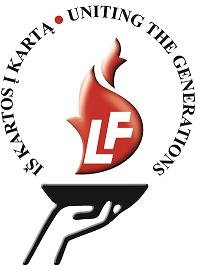Latin America
Statistics on the number of Lithuanians in Latin America vary wildly, putting the number anywhere between 60 000 to 1 000 000. It depends on who is to be considered Lithuanian as there is generally less participation in Lithuanian activities than in the USA or Western Europe. Many people of Lithuanian descent are now assimilated as in many cases they did not form ethnic enclaves and spread across large territories.
There have been Lithuanians in Latin America as early as the start of 19th century participating in the independence movements. Ignatas Domeika (also known in Polish as Ignacy Domeyko and in Spanish as Ignacio Domeyko) has a mountain named after him in Chile.
The real birth of Latin America's Lithuanian community was the interwar period (1920s - 1930s). In 1908 USA curbed immigration and Lithuanians opted for Brazil, Argentina and Uruguay instead. Argentina and Uruguay were as rich as Western Europe at the time and not far behind the USA. Brazil was poorer but had jobs in its extensive plantations.
60% of all 1926-1940 Lithuanian emigrants emigrated to these three countries. They published Lithuanian newspapers and created institutions. In general, they were poorer than Lithuanians in the USA and had less civil rights. Some used South America as a trampoline to the USA.
Latin America of the early 20th century still had vast unpopulated spaces so Lithuanians also participated in the establishment of new towns, e.g. Ijui (Rio Grande do Sul, Brazil) and Esquel (Chubut, Argentina). In the cities, they established Lithuanians were soon outnumbered by other immigrant communities. Lithuanian culture survived better in the region's metropolises (Buenos Aires, Rosario). There is a Lithuanian district in Sao Paulo, Brazil (Villa Zelina) centered around a Lithuanian church. Lithuanian parishes, dance troupes, and clubs exist in multiple Argentine and Uruguayan cities.
The last sizeable Lithuanian migration to Latin America was that of refugees in late 1940s who established the Lithuanian communities in Colombia and Venezuela. Never numbering more than 2000 they were nevertheless influential as most of their members were elite (artists, professionals). Antanas Mockus, a university professor, former mayor of Bogota and presidential candidate is a Lithuanian Colombian.
In the same era, J. Stalin invited interwar Lithuanian emigrants to return (for propaganda purposes), falsely promising riches. Some returned; those who could then left again for South America soon but this option was not possible to everyone.
After 1950s Lithuanian Latin Americans were never replenished by new immigrants. In 1945-1990 emigration was banned by occupational Soviet authorities. After 1990 Latin America was already relatively poor and Lithuanians favored the USA, Western Europe, and Australia as their new foreign homes. Intermarriage in the older communities triggered assimilation but some did marry within the community and there are 4th generation Lithuanians who still speak Lithuanian at home.
There has been upsurge in interest in Lithuanian roots after Lithuania joined the European Union as the Lithuanian passport now provides a possibility to work in Western Europe.






February 11th, 2013 - 17:25
Labai graziai sudeliota ir man labai reiklainga informacija, bet turiu klausima, is kur ggauti apie atrpukario/pokario informacija pirminiu saltiniu/istoriniu duomenu? Dekoju!
February 12th, 2013 - 02:58
Labas, o kokios būtent informacijos reikia? Kol kas Lotynų Amerikos lietuvių bendruomenių plačiau netyrinėjau, priešingai nei JAV ar Europos. Tačiau tai, kas surašyta šiame tekste remiasi Stasio Vaitiekūno knyga “Lietuvos gyventojai” (pvz. tarpukario emigrantų procentai; psl. 299). Informacijos apie lietuviškas bažnyčias, bendruomenes ir kt. seniau buvo Lietuvos ambasados Argentinoje, atstovavusios Lietuvą ir kitose Lotynų Amerikos šalyse, tinklapyje. Deja šią ambasadą 2013 m. gruodžio 31 d. Lietuva uždarė.
April 24th, 2013 - 23:27
Labas
I am a Lithuanian-American living presently in Chicago.
I am traveling to São Paulo in June and would appreciate
Some references to the Lithuanian community there.
I traveled to São Paulo back in the 1970’s with the Lithuanian
Student Union.
I would like to find some friends that I met then, with whom
I have lost touch.
I believe you mentioned Vila Zelina as a location that still has
A Lihuanian population.
If possible could you please provide a contact, club or church
for me ?
Labai Aciu
Algis Ankus
April 26th, 2013 - 21:13
Labas,
I tried to colect information available online for you on Lithuanian heritage in Brazil. A new article is now available via this link.
March 14th, 2014 - 19:14
Ar saugu yra lankytis Kolumbijoje ir Brazilijoje? Girdėjau, kad ypač Kolumbija nėra saugus kraštas užsieniečiams.
Įdomu, ar be Antano Mackaus dar yra lietuvių Bagotoje? Brazilija mane traukia jau senai, norėčiau ten lankytis be turistinės grupės. Ar galima rasti kontaktų su lietuviais tuose kraštuose.
Gyvenu Vilniuje, esu Britanijos ir Lietuvos pilietis.
algirdas
March 15th, 2014 - 00:00
Sveikas,
Šiose šalyse nesu buvęs, tačiau Lotynų Amerikoje esu lankęsis be grupės (Meksikoje, Peru, Čilėje). Be abejo, verta atkreipti dėmesį į nusikalstamumo statistiką (kuri dažnai nekokia), bet reikia suprasti, kad milijonai žmonių tose šalyse gyvena ir nėra apvagiami kas mėnesį. Tačiau keliavimas (kaip ir gyvenimas) ten saugumo dėlei gali būti šiek tiek labiau ribotas, nei saugiose šalyse: į daug rajonų geriau neiti sutemus, į kai kuriuos vienam neiti išvis (kita vertus pastaruosiuose – lūšnynuose – paprastai ir nelabai yra ką žiūrėti). Pastebėsite, kad vietiniai irgi imasi tokių saugumo priemonių, o bet kuris gražesnis namas supamas aukštų tvorų su spygliais ar elektra. Kolumbijoje lietuvių yra, tačiau palyginus su Brazilija ir Argentina tai gana nedidelė bendruomenė (keli šimtai žmonių), imigravusi bėgdama nuo sovietų pokariu, apie lietuvišką paveldą (bažnyčias, lietuvių namus ir pan.) žinių aptikti man nepavyko.